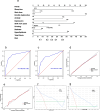The association between shift work, shift work sleep disorders and premature ejaculation in male workers
- PMID: 38961338
- PMCID: PMC11223354
- DOI: 10.1186/s12889-024-19141-1
The association between shift work, shift work sleep disorders and premature ejaculation in male workers
Abstract
Objective: Shift work and Shift Work Sleep Disorder (SWSD) are known to affect the secretion of several neurotransmitters and hormones associated with premature ejaculation (PE). However, their specific influence on the regulation of male ejaculation remains unclear. This study explores the relationship between shift work, SWSD, and PE.
Methods: From April to October 2023, a cross-sectional survey was conducted across five regions of China to explore the work schedules, sleep quality, and sexual function of male workers. Participants' sleep quality was evaluated using a validated SWSD questionnaire, and their erectile function and ejaculatory control were assessed with the International Inventory of Erectile Function (IIEF-5) scores and Premature Ejaculation Diagnostic Tool (PEDT) scores, respectively. Univariate and multivariate linear regression analyses were employed to identify risk factors associated with PE. Confounders were controlled using multiple regression models, and clinical prediction models were developed to predict PE onset and assess the contribution of risk factors.
Results: The study included 1239 eligible participants, comprising 840 non-shift workers and 399 shift workers (148 with SWSD and 251 without SWSD). Compared to non-shift working males, those involved in shift work (β 1.58, 95% CI 0.75 - 2.42, p < 0.001) and those suffering from SWSD (β 2.86, 95% CI 1.86 - 3.85, p < 0.001) they had significantly higher PEDT scores. Additionally, we identified daily sleep of less than six hours, depression, anxiety, diabetes, hyperlipidemia, frequent alcohol consumption (more than twice a week), and erectile dysfunction as risk factors for PE. The predictive model for PE demonstrated commendable efficacy.
Conclusion: Both shift work and SWSD significantly increase the risk of premature ejaculation, with the risk magnifying in tandem with the duration of shift work. This study reveals the potential impact of shift work and SWSD on PE and provides new theoretical foundations for the risk assessment and prevention of this condition.
Keywords: Predictive model; Premature ejaculation; Risk factors; Shift work; Shift work sleep disorder.
© 2024. The Author(s).
Conflict of interest statement
The authors declare no competing interests.
Figures


Similar articles
-
Shift Work Sleep Disorder and Night Shift Work Significantly Impair Erectile Function.J Sex Med. 2020 Sep;17(9):1687-1693. doi: 10.1016/j.jsxm.2020.06.009. Epub 2020 Jul 28. J Sex Med. 2020. PMID: 32736945 Free PMC article.
-
[Correlation between premature ejaculation diagnostic tool and International Index of Erectile Function-15 in different types of premature ejaculation].Zhonghua Nan Ke Xue. 2016 Sep;22(9):777-781. Zhonghua Nan Ke Xue. 2016. PMID: 29071872 Chinese.
-
Increased Risk of Hypogonadal Symptoms in Shift Workers With Shift Work Sleep Disorder.Urology. 2020 Apr;138:52-59. doi: 10.1016/j.urology.2019.10.040. Epub 2020 Jan 7. Urology. 2020. PMID: 31917971
-
The Relationship Between Shift Work and Men's Health.Sex Med Rev. 2018 Jul;6(3):446-456. doi: 10.1016/j.sxmr.2017.11.009. Epub 2018 Jan 19. Sex Med Rev. 2018. PMID: 29371140 Review.
-
Shift work sleep disorder: burden of illness and approaches to management.Drugs. 2006;66(18):2357-70. doi: 10.2165/00003495-200666180-00007. Drugs. 2006. PMID: 17181377 Review.
Cited by
-
Association Between Fine Particle Waves and Sexual Function: A Nationwide Cross-Sectional Survey in China.Toxics. 2025 Jan 6;13(1):39. doi: 10.3390/toxics13010039. Toxics. 2025. PMID: 39853037 Free PMC article.
References
Publication types
MeSH terms
LinkOut - more resources
Full Text Sources
Miscellaneous

